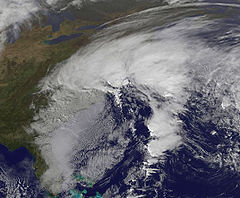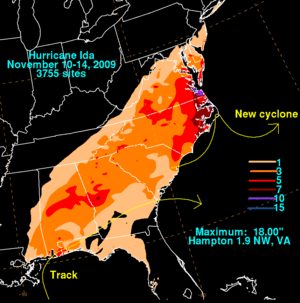- November 2009 Mid-Atlantic nor'easter
-
November 2009 Mid-Atlantic nor'easter ("Nor'Ida") Satellite image of the storm on November 12 Storm type: Nor'easter Formed: November 11, 2009 Dissipated: November 17, 2009 Maximum
amount:*None; 18 in (460 mm) of rain in Hampton, Virginia Lowest
pressure:992 mbar (hPa; 29.29 inHg) Damages: $300 million (2009 USD) Fatalities: 6 direct Areas affected: Mid-Atlantic States and New England ^* Maximum snowfall or ice accretion
The November 2009 Mid-Atlantic nor'easter (also referred to as "Nor'Ida") was a powerful autumn nor'easter that caused widespread damage throughout the east coast of the United States. This extratropical cyclone formed in relation to Hurricane Ida's mid-level circulation across southeastern Georgia and moved east-northeast offshore North Carolina before slowly dropping south and southeast over the succeeding several days.
Contents
Synoptic history
The origins of the nor'easter are with the remnants of Hurricane Ida which formed on November 4 over the southern Caribbean Sea.[1] After tracking through Nicaragua as a Category 1 hurricane, the system attained Category 2 status over the Yucatán Channel. Once in the Gulf of Mexico, the combination of increasing wind shear and cooler waters caused Ida to weaken. The system eventually moved over the southeastern United States on November 10 before transitioning into an extratropical cyclone. Ida eventually dissipated over the Florida Panhandle.[1] However, Ida's mid-level circulation led to the formation of a new low over southeastern Georgia, which eventually moved off the coast of North Carolina.[2] This new low quickly intensified and became a powerful nor'easter that caused substantial damage throughout the Mid-Atlantic States.[1] Due to the rapid succession of these systems, United States media referred to the nor'easter as "Nor'Ida".[3] By November 12, the system attained a minimum pressure of 992 mbar (hPa; 29.29 inHg) along with winds of 65 mph (100 km/h).[4] In combination with a large area of high pressure, a long stretch of easterly, onshore winds impacted areas from Virginia to southern New England.[5] Tracking parallel to the North Carolina coastline, the system eventually moved onshore near Cape Hatteras by November 13. Due to the high pressure system situated over Vermont, the low turned southeastward, bringing its center back over water. Gradual weakening took place during this period, though heavy rains continued to fall across much of the Chesapeake Bay area. On November 14, a brief secondary low developed off the coast of Delaware.[2] Continuing to weaken, the cyclone resumed a northward track after the high weakened and persisted through November 17, by which time it had moved over Atlantic Canada.[6]
Preparations
As the remnants of Ida began to weaken within the developing nor'easter on November 11, flood warnings were already in force from Alabama to Georgia and watches extended northward into the Mid-Atlantic states. Coastal flood watches and high wind warnings were also in effect from North Carolina to Delaware.[7] Flood warnings were later expanded into South Carolina and coastal advisories were extended to New Jersey and Long Island.[8][9] Gale warnings continued to grow in coverage, encompassing areas from North Carolina to New Jersey by the afternoon of November 12.[10] By November 13, the watches and warnings gradually began to be discontinued as the low moved offshore.[11] Although the Hydrometeorological Prediction Center issued their final advisory on the system later on November 13, flood advisories remained in effect due to residual impacts from the cyclone.[12]
Impact
Storm surge
Due to the location of the storm, south east of the Chesapeake Bay, persistent onshore flows brought elevated water levels to some areas for up to four days. This also brought a storm surge to much of the region and in some cases, these surges reached record levels set by Hurricane Isabel in 2003.[2] In Norfolk, Virginia, a maximum storm surge of 7.74 ft (2.36 m) was measured on November 13.[13] Five coastal measuring stations recorded record-high water levels during the event and three were within 0.5 ft (0.15 m). Despite the nor'easter not being nearly as intense as Hurricane Isabel, water levels rivaled that of the hurricane because of persistent onshore flows, elevating water levels for several days.[2]
Southeastern states
Along the east coast of the United States, a nor'easter spawned by the remnants of Ida resulted in widespread damage along coastal areas.[1] Minor damage was reported in South Carolina as winds up to 45 mph (75 km/h) and heavy rains, amounting to 3 to 5 in (76 to 130 mm) in most of the state, impacted the region. One person was killed after his vehicle collided with a downed tree in.[14] Flash flooding took place in some areas due to the heavy rains and previously saturated grounds.[15] In North Carolina strong winds downed several trees loosened in saturated soil. In Rockingham County, one person was killed after being struck by a branch while driving.[16] In the Outer Banks, four homes were destroyed and over 500 others were damaged by the system, leaving at least $5.8 million in losses.[17]
Mid-Atlantic
Along the Delmarva Peninsula, waves up to 10 ft (3.0 m) caused some coastal damage and high winds left roughly 13,000 without power. In Delaware alone, damage was estimated at $45 million.[18] The most severe damage took place in New Jersey where coastal losses were estimated to be at least $180 million. Extensive sand loss was reported at numerous beaches, including 7 million cubic yards in Ocean City alone.[19] In New York, one person drowned after being caught in rough seas off Rockaway Beach.[20] Total beach losses in the state reached $8.2 million.[21] Further north, the remnants of the cyclone brought heavy rains to portions of New England, resulting in flash flooding. In Maine, the highest rainfall total was recorded in Wells at 6.3 in (160 mm). In Cumberland County, one river rose 3.76 ft (1.15 m) above flood-stage, inundating nearby areas.[22]
Virginia
Widespread coastal damage and major flooding took place in Virginia as rainfall exceeding 7 in (180 mm) fell in many places and large waves affected beaches.[1][6] A maximum rainfall of 18 in (460 mm) fell in Hampton during the storm.[6] In some areas, roads were closed multiple times due to flooding. Minor damage was also reported as a few homes were inundated with up to 1 ft (0.30 m) of water. Some areas reported a storm surge comparable to that of Hurricanes Gloria in 1985 and Isabel in 2003.[23] Damage from the storm in Virginia was estimated to be at least $38.8 million, of which $25 million was in Norfolk alone.[4] According to the National Weather Service, 7.4 in (190 mm) of rain fell in Norfolk between November 11 and 13, nearly three times the monthly average for November; in those three days alone, the total rainfall surpassed the monthly record of 7.02 in (178 mm) set in 1951. Hurricane-force winds also affected the state, with a peak gust of 75 mph (121 km/h) occurring in Oceana.[13]
Aftermath
Following the widespread flooding caused by the storm, a major disaster declaration was signed by President Barack Obama on December 9 to provide residents in Virginia with federal assistance. According to the Federal Emergency Management Agency (FEMA), the cost of public assistance in the state would reach $11,227,376.[24]
See also
- Winter storms of 2009-2010
- 2009 Atlantic hurricane season
References
- ^ a b c d e Lixion A. Avila and John Cangialosi (January 14, 2010). "Hurricane Ida Tropical Cyclone Report" (PDF). National Hurricane Center. http://www.nhc.noaa.gov/pdf/TCR-AL112009_Ida.pdf. Retrieved February 27, 2010.
- ^ a b c d Kathleen Egan, Laurita Brown, Karen Earwaker, Colleen Fanelli, Adam Grodsky and Aijun Zhang (May 2010). "Effects of the November 2009 Nor'easter on Water Levels" (PDF). National Oceanic and Atmospheric Administration. http://tidesandcurrents.noaa.gov/publications/tech_rpt_56.pdf. Retrieved December 22, 2010.
- ^ St. Petersburg Coastal and Marine Science Center (March 26, 2010). "Nor'Ida". United States Geological Survey. http://coastal.er.usgs.gov/hurricanes/norida/. Retrieved December 23, 2010.
- ^ a b "Hurricane Season 2009: Ida the Coastal Low". National Aeronautics and Space Administration. December 4, 2009. http://www.nasa.gov/mission_pages/hurricanes/archives/2009/h2009_Ida.html. Retrieved February 27, 2010.
- ^ Paul J. Kocin (November 12, 2009). "Public Advisory 34 for Remnants of Ida". Hydrometeorological Prediction Center. http://www.hpc.ncep.noaa.gov/tropical/2009/IDA/IDA_34.html. Retrieved December 22, 2010.
- ^ a b c David M. Roth (2010). "Hurricane Ida - November 10–14, 2009". Hydrometeorological Prediction Center. http://www.hpc.ncep.noaa.gov/tropical/rain/ida2009.html. Retrieved February 27, 2010.
- ^ Michael T. Eckert (November 12, 2009). "Public Advisory Number 32 for Remnants of Ida". Hydrometeorological Prediciton Center. http://www.hpc.ncep.noaa.gov/tropical/2009/IDA/IDA_32.html. Retrieved December 22, 2010.
- ^ Michael T. Eckert and Paul A. Ziegenfelder (November 12, 2009). "Public Advisory 33 for Remnants of Ida". Hydrometeorological Prediction Center. http://www.hpc.ncep.noaa.gov/tropical/2009/IDA/IDA_33.html. Retrieved December 22, 2010.
- ^ David M. Roth (November 12, 2009). "Public Advisory 35 for Remnants of Ida". Hydrometeorological Prediction Center. http://www.hpc.ncep.noaa.gov/tropical/2009/IDA/IDA_35.html. Retrieved December 23, 2010.
- ^ Paul A. Ziegenfelder (November 12, 2009). "Public Advisory 36 for Remnants of Ida". Hydrometeorological Prediction Center. http://www.hpc.ncep.noaa.gov/tropical/2009/IDA/IDA_36.html. Retrieved December 23, 2010.
- ^ Marybeth Gerhardt (November 13, 2010). "Public Advisory 38 on Remnants of Ida". Hydrometeorological Prediction Center. http://www.hpc.ncep.noaa.gov/tropical/2009/IDA/IDA_38.html. Retrieved December 23, 2010.
- ^ David M. Roth (November 13, 2009). "Public Advisory 39 on Remnants of Ida (Final)". Hydrometeorological Prediction Center. http://www.hpc.ncep.noaa.gov/tropical/2009/IDA/IDA_39.html. Retrieved December 23, 2010.
- ^ a b National Weather Service (November 2010). "November 11-13th, 2009 Nor'easter" (PDF). National Oceanic and Atmospheric Administration. http://www.erh.noaa.gov/er/akq/wx_events/other/November%2011-13th%20Noreaster.pdf. Retrieved October 14, 2010.
- ^ "South Carolina Event Report: Strong Wind". National Climatic Data Center. 2010. http://www4.ncdc.noaa.gov/cgi-win/wwcgi.dll?wwevent~ShowEvent~788075. Retrieved February 27, 2010.
- ^ "South Carolina Event Report: Flash Flood". National Climatic Data Center. 2010. http://www4.ncdc.noaa.gov/cgi-win/wwcgi.dll?wwevent~ShowEvent~788076. Retrieved December 23, 2010.
- ^ "North Carolina Event Report: Strong Winds". National Climatic Data Center. 2010. http://www4.ncdc.noaa.gov/cgi-win/wwcgi.dll?wwevent~ShowEvent~788001. Retrieved February 27, 2010.
- ^ "North Carolina Event Report: Coastal Flood". National Climatic Data Center. 2010. http://www4.ncdc.noaa.gov/cgi-win/wwcgi.dll?wwevent~ShowEvent~788167. Retrieved February 27, 2010.
- ^ "Delaware Event Report: Coastal Flood". National Climatic Data Center. 2010. http://www4.ncdc.noaa.gov/cgi-win/wwcgi.dll?wwevent~ShowEvent~788480. Retrieved February 27, 2010.
- ^ "New Jersey Event Report: High Winds". National Climatic Data Center. 2010. http://www4.ncdc.noaa.gov/cgi-win/wwcgi.dll?wwevent~ShowEvent~788465. Retrieved February 27, 2010.
- ^ "New York Event Report: High Surf". National Climatic Data Center. 2010. http://www4.ncdc.noaa.gov/cgi-win/wwcgi.dll?wwevent~ShowEvent~788306. Retrieved February 27, 2010.
- ^ "New York Event Report: High Surf". National Climatic Data Center. 2010. http://www4.ncdc.noaa.gov/cgi-win/wwcgi.dll?wwevent~ShowEvent~788509. Retrieved February 27, 2010.
- ^ "Maine Event Report: Flood". National Climatic Data Center. 2010. http://www4.ncdc.noaa.gov/cgi-win/wwcgi.dll?wwevent~ShowEvent~788268. Retrieved February 27, 2010.
- ^ "Virginia Event Report: Coastal Flood". National Climatic Data Center. 2010. http://www4.ncdc.noaa.gov/cgi-win/wwcgi.dll?wwevent~ShowEvent~788468. Retrieved February 27, 2010.
- ^ "Virginia Severe Storms and Flooding Associated with Tropical Depression Ida and a Nor’easter" (PDF). Federal Emergency Management Agency. December 9, 2009. http://www.fema.gov/pdf/news/pda/1862.pdf. Retrieved December 22, 2010.
External links
Categories:- 2009 meteorology
- Nor'easters
- 2009 natural disasters
Wikimedia Foundation. 2010.




